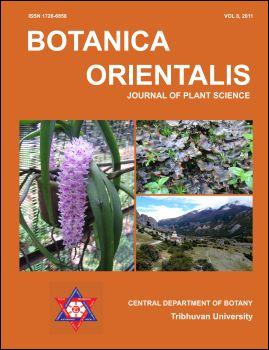Bee flora in mid hills of Central Nepal
DOI:
https://doi.org/10.3126/botor.v8i0.5558Keywords:
beekeeping, dearth period, Honey flow, honey dew, nectar source, pollen sourceAbstract
Beekeeping is one of the promising ventures for economically poor families in Nepal. Knowledge about the bee flora of a certain area is very crucial for the farmers. A study was conducted in mid hills of Central Nepal during 2003-04 and 2008-09 to monitor the common plant species visited by bees with their visiting time and seasons. The flowering period of those plant species were also observed. Observations were made on the bees’ activities on flowers of different plant species. Relevant information was also collected through informal key informant interviews. The plant species visited by the bees and the bee species (mainly Apis cerena with some Apis melifera) themselves were collected, preserved and identified. Plants were categorized as major, medium and minor sources of pollen and/or nectar. The pollen and nectar statuses in different plants were also determined. A total of 158 plant species were identified as main bee flora in the study area. Among them, 19 species were horticultural plants, 42 species were crop plants, 15 species were ornamental plants and 82 species were wild plants. In total, 38 species were recognized as major, 35 as medium and 30 as minor sources for both nectar and pollen. Months from March to May and August to October were the honey flow periods. Species of Brassica, Citrus, Pyrus, Berberis, Rubus, Callistemon, Bombox and Artemisia were some of the important plants which bloomed during those months. Winter (mid November to January) and rainy (June and July) seasons were identified as the dearth periods for bees to collect honey. Some of the plants that bloom during winter were Pisum sativum, Ipomoea batata and Eupatorium sp. Similarly, Lagerstroemia sp., Impatiens balsamina, Sesamum indicum, Zea mays and many cucurbits bloomed during rainy season. Study has shown that mid-hills of Central Nepal is rich in bee flora and has great potential for beekeeping as many plants bloomed even in dearth periods.
doi: http://dx.doi.org/10.3126/botor.v8i0.5558
Botanica Orientalis – Journal of Plant Science (2011) 8: 45-56
Downloads
Downloads
Published
How to Cite
Issue
Section
License
This license enables reusers to copy and distribute the material in any medium or format in unadapted form only, for noncommercial purposes only, and only so long as attribution is given to the creator.




